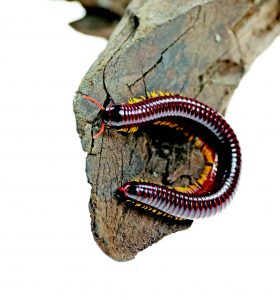While most people shy away from critters, millipede enthusiasts can’t have enough of the Flameleg Millipede, so-named because of the fiery colors of their legs. Of course, there is so much more about the Trigoniulus macropygus than its vibrant hues.
All About the Flameleg Millipede
The Trigoniulus macropygus, also known as the flameleg millipede, is a local millipede species with very striking colors. Their coloration is the reason why Trigoniulus macropygus is slowly gaining popularity in the pet trade. They can be low-maintenance pets and look really good in any terrarium, too. However, one shouldn’t be fooled by its good looks. The Trigoniulus macropygus is actually a toxic species.

While millipedes are closely related to centipedes, they have two pairs of legs in each segment, unlike centipedes that possess a pair of legs per segment. The mouth parts of the millipede are made for nibbling and can’t cut or tear food like carnivorous insects, such as mantises.
Millipedes are very sensitive to sound and vibrations, so they can sense potential predators a few feet away. They have developed a unique defense mechanism allowing them to spray a unique toxin when threatened.
The flameleg millipede is not an invertebrate ideal for handling because of its toxic secretions. Nevertheless, the flameleg millipede plays an important role in its natural habitat.
Habitat
Flameleg millipedes are often found in moist areas and tropical forests. In the Philippines, they are commonly found near waterfalls, rivers, and streams. If you’re lucky, you might even find one in your garden during the wet season.
They feed on vegetation from the soil and help degrade plant matter in their natural environment. They can also feed on some types of soft wood.
They have very few predators in the wild. Because of their very efficient defense mechanism, they can ward off predators easily.
Diet
Flameleg millipedes are herbivores and do not eat other animals or other insects. In fact, their mouth parts are not made for biting at all; they are appropriate only for nibbling food items often found in the soil.
In the wild, millipedes eat fruit, mushroom, rotting wood, rotting leaves, and vegetables. However, when in captivity, they also accept moistened cat food or moistened fish food. They aren’t picky eaters at all and they readily accept any food item in their substrate.If you plan to keep flameleg millipedes as pets, keep in mind that food might easily go bad and it might attract mites or fungi if not removed. Both of these might harm your millipedes, so the leftovers of millipedes must also be collected regularly.
Nature Knows Best
If you happen to find a flameleg millipede in the wild, it is best to leave them alone, unless you want to experience their nasty toxic spray.
Captive-bred millipedes are more stable compared to wild-caught millipedes because they are already used to the enclosure parameters and diet in captivity. The flameleg millipede might look interesting and harmless, but they are not recommended for kids and first-time millipede keepers.
As they are toxic, they should not be handled with bare hands.
For Expert Handlers Only
The flameleg millipede is really unique. However, they are quite difficult to care for in captivity because of the parameters necessary to keep them alive.
A bioactive set up works well for millipedes, but make sure that predation will not occur.
This appeared in Animal Scene magazine’s July 2018 issue.






